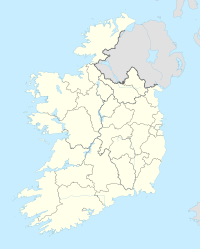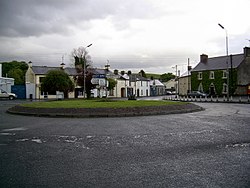Castlepollard
| Baile na gCros Castlepollard |
||
|---|---|---|
|
|
||
| Coordinates | 53 ° 39 ′ N , 7 ° 13 ′ W | |
| Basic data | ||
| Country | Ireland | |
| Leinster | ||
| county | Westmeath | |
| ISO 3166-2 | IE-WH | |
| height | 88 m | |
| Residents | 1163 (2016) | |
|
Castlepollard, Round point
|
||
Castlepollard ( Irish Baile na gCros , English Ballinagross or Irish Cionn Toirc , English Kinturk ) is a larger town in the north of Westmeath County , Leinster Province , in the Republic of Ireland .
Place name
Castlepollard is west of Lough Lene and northeast of Lough Derravaragh and the county capital, Mullingar . The name is derived from a fortification built by Nicholas Pollard, Captain of the English Army, at the beginning of the 17th century. The Irish names are Baile na gCros ("City of Crosses", anglicised Ballinagross ), but also Cionn Toirc ("boar head", Anglicised Kinturk ). Today, Kinturk Demesne is understood to mean the southern local area.
history
During the Nine Years War , Captain Nicholas Pollard came to Ireland from Devonshire in 1597 . Under the command of Robert Devereux, 2nd Earl of Essex , he fought against the Irish Army under Aodh Mór Ó Néill, 2nd Earl of Tyrone . After the war he was given land ownership as part of the Plantations . The fertile area of Cionn Torc (Kinturk) was given to him by Queen Elizabeth I in capite ("as the first of his tribe"). There he built a small fortress, which he called Castle Pollard . His eldest son, Walter Pollard, became High Sheriff of Roscommon in 1692 (the chief judicial representative of the British Crown in the county). During this time, the place developed quickly, received the weekly market rights and the permission to hold a quarterly parish fair. The descendants of the family lived in the district of Kinturk Demesne until the early 20th century.
On the hills around the town there are some ring forts , of which Randoon , a fortification from the Viking Age southwest of Lough Lene, is of archaeological importance.
Townscape
The well-preserved historical center is now lined with buildings from the time of Georgian architecture , which were renovated in the early 19th century. In a triangular square is a sculpture depicting the local legend of Lough Derravaragh, Oidheadh Chlainne Lir ("The Story of the Lir Children").
Castlepollard has a Roman Catholic Church and one of the Church of Ireland . Kintuck House, the Georgian residence of the Pollards, has served as a Christian hospice since 1935, which is looked after by the Sacred Heart Sisters and which also served as a poor sanctuary for many years.
During the Irish War of Independence , the Irish Republican Army (IRA) destroyed the barracks of the Royal Irish Constabulary (RIC), which then moved to the courthouse. From 1921 there were further attacks, which also fell victim to the market hall; after its reconstruction in 1926, it now serves as a fire station. A regional office for Westmeath County Council was built on Mullingar Road and in 2004 the new school building for Castlepollard Community College .
A molded parts manufacturing company is the city's main employer, which also owns a few small shops, various pubs and a hotel.
Sports
The Lough Lene Gaels hurling team represents the most popular sport in the region.
There is the Castlepollard Celtic Football Club , founded in 2004, it plays in the Athlone & District Schoolboys League and since 2009 in the Longford & District Schoolboys / girls League from Under 7's to Under 16's . The club has around 200 active members and plays on the Castlepollard Community College sports field .
Tullynally Castle
West of Castlepollard, 2 km away, is Tullynally Castle (also called Pakenham Hall , Irish Caisleán Thulaigh an Eallaigh ) the seat of the Pakenham family, later elevated to Earls of Longford . Erected as a castle around 1655, it was converted into a Georgian castle building around 1730 and then in neo-Gothic style. The lady of the castle Catherine Pakenham (1773-1831) was the wife of Arthur Wellesley, 1st Duke of Wellington , the victor in the Battle of Waterloo .
The description of the still privately owned castle by The Irish National Inventory of Architectural Heritage reads:
- "... a magnificent sprawling castle, with a picturesque skyline of turrets, pinnacles, battlements and tall Tudoresque chimneystacks ... The attention to detail displayed throughout and the quality of the workmanship is outstanding and Tullynally Castle is, without question, a hugely significant structure of national importance. "
A 12 hectare garden was laid out in the 18th century. Two artificial lakes, a limestone grotto from Lough Derravaragh, a Chinese garden with a pagoda and a Tibetan garden with artificial waterfalls, as well as wooden sculptures from the grown trees adorn the woodland garden (nature park); an all of 200 year old Irish yew trees is the focal point of the walled garden . The park is open to the public in spring and summer.
The current 8th Earl of Longford, Thomas Pakenham , is a noted historian and tree specialist, and is Chairman of the Irish Tree Society .
Web links
- Castlepollard homepage
- Area map at Irish tourist.com
- Castlepollard Celtic Football Club homepage
Individual evidence
- ↑ Castlepollard (Census Town) on citypopulation.de, accessed on June 18, 2019



